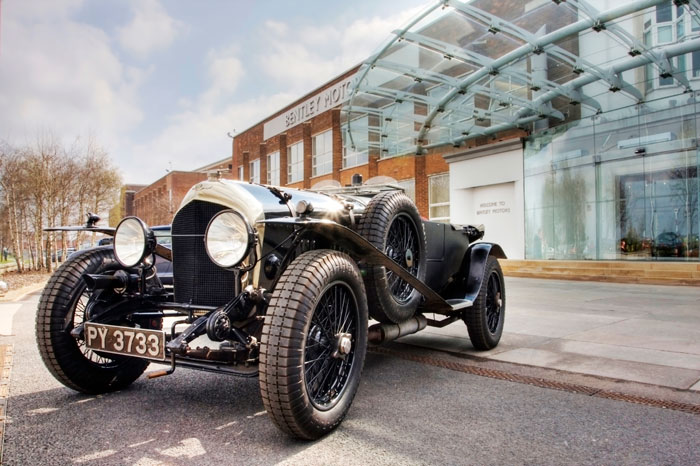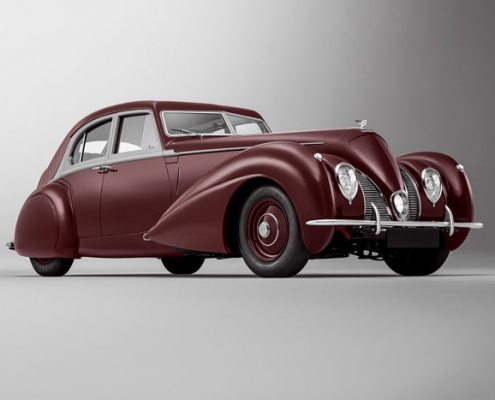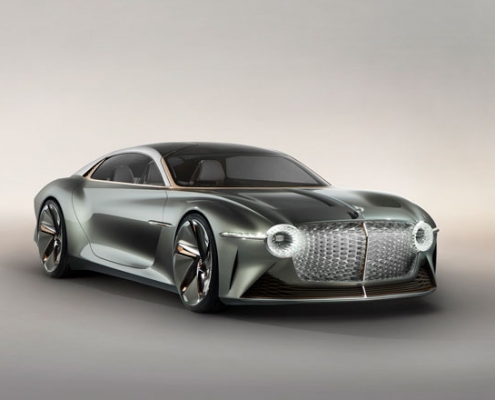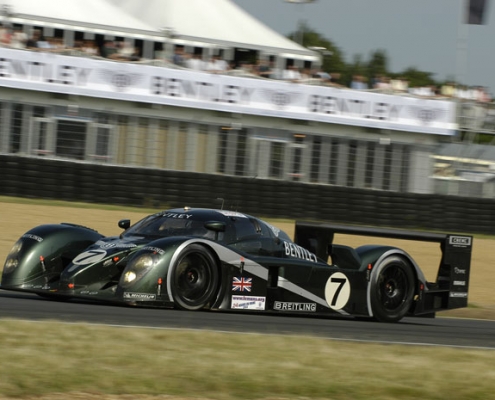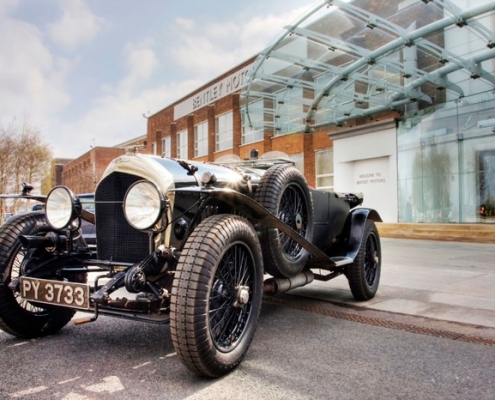Bentley: 100 years of Legend and Luxury
In 1919, Walter Owen Bentley (known as W.O. Bentley) established the car company that would bear his name.
In the century since, Bentley has become one of the world’s great automotive names, a company whose cars are synonymous with luxury, power and quality.
From the beginning, quality was what it was all about, with W.O. saying at the birth of the company that, “We were going to make a fast car, a good car, the best in its class.”
It took just 11 years for this upstart car maker to stake a claim to being one of the world’s best. By 1930, and with the help of a group of adventurous souls known as the Bentley Boys, Bentley had secured five wins at Le Mans, made plenty of headlines and was making a series of remarkable and powerful cars.
It wasn’t all plain sailing, of course. As was to happen to many British automakers over the years, financial troubles would see Bentley bought and sold a few times over the years and it would at one time or another, be owned by Rolls-Royce, Vickers and Volkswagen (the brand’s parent company to this day), and its popularity fluctuate many times over the decades.
Today, however, Bentley is as strong as it has ever been. A slate of very capable cars over the past couple of decades – including a move into the ever-popular SUV market with the Bentayga – dedicated enthusiasts, a strong vision of the future exemplified by a string of awesome concept vehicles and a continuing presence in motorsport with the Continental GT3 look to ensure the company will have a solid future.
In this edition we look at some of the cars that have made Bentley one of the auto industry’s great names.
BENTLEY 3 LITRE (1919)
W.O. Bentley made three prototypes in the early years of the company’s existence: EXP 1 (EXPerimental No.1) which first ran in October 1919; EXP 2 built later that year and which cannibalised much of EXP 1; and EXP 3, known as ‘The Cab’ and which was also W.O. Bentley’s personal car.
EXP 2 is the oldest Bentley in existence and made its debut at the 1919 Olympia Motor Show in London.
Drawing influence from W.O. Bentley’s pre-war competition experience – when he pioneered the use of aluminium pistons – EXP 2 is also the brand’s first car to win a race, its 129km/h top speed coming via a its 3.0-litre four-cylinder engine.
BENTLEY 4.5 LITRE & BENTLEY BLOWER (1927)
Introduced in 1927, the Bentley 4½ Litre was a great success, notching up a victory at Le Mans in 1928 driven by Bentley Boys Woolf Barnato and Bernard Rubin. But perhaps the most famous incarnation of this car was the Bentley Blower – a 4½ Litre with a supercharger stuck on the front.
Though the 4½ Litre was a winner, there were those who thought it could do with a boost in power. For W.O. Bentley, that meant more displacement but for others, forced induction via a supercharger looked promising.
In 1929, one of the Bentley Boys, Tim Birkin, commissioned a series of 4½ Litre Bentleys to be fitted with a supercharger – a move that saw power shoot up from 10bhp to 175bhp and up to 240bhp for the full racing version.
W.O. Bentley did not like the idea but by this time he had lost control of the company and his opposition was overridden and Birkin’s project was approved. However, W.O.’s unwillingness to incorporate the supercharger into the engine did stand and it made for the unique sight of the Blower Bentleys’ superchargers sitting very obviously out the front of the engine.
The Blower was certainly a fast machine and Birkin set a number of records in versions of it. However, it was not considered reliable in endurance racing and though two were entered into the 1930 Le Mans race, neither finished. However, it did make quite a splash at the French Grand Prix that year with Birkin piloting the huge vehicle to second place against a field of lightweight racers. These included that year’s winning car, a Bugatti Type 35. The man behind the Type 35, Ettore Bugatti, was, it is said, moved to say that the Bentley Blower was the “fastest lorry in the world.”
BENTLEY 8 LITRE (1930)
The last car Bentley to be designed by W.O. Bentley himself, the 8 Litre was the largest and most luxurious Bentley of its time. Powered by an 8-litre, straight-6 engine punching out 230bhp – back then, the largest engine on any car in the UK – the company guaranteed the 8 Litre would be capable of at least 100mph, regardless of the chosen coachwork.
BENTLEY CORNICHE (1939)
This is the 1939 Corniche, a unique vehicle rebuilt and restored for Bentley’s centenary.
The Corniche introduced ‘Streamlining’ styling that was aimed at delivering speed and performance and pointed to the direction future designs Bentley would introduce – as was evident in the later R-Type Continental.
The original Corniche was lost in France in 1939 at the outbreak of World War II. It was badly damaged in a traffic accident whilst undergoing road tests in August 1939. Sent for repairs, the chassis made it home to the Bentley plant in Derby, but the bodywork was destroyed in a bombing raid on Dieppe later that year. The stunning restoration shows just what a glorious car the Corniche was.
R-TYPE CONTINENTAL (1952)
Inspired in part by the Corniche, the R-Type Continental (the first time Bentley to be bestowed that illustrious name) is a magnificent-looking car that was designed with European touring in mind. It was to be capable of running for long periods at high speed across the continent.
A tuned, 4,566cc, six-cylinder in-line engine generating 153bhp was under the bonnet, and the body was made from lightweight aluminium. Along with the improved aerodynamics, these elements enabled the R Type to claim a top speed of 194km/h, making it the fastest four-seater in the world at the time.
208 of the R Types were built over its three years of production, with 193 of the bodies from coachbuilder Mulliner. All this beauty and luxury came at a price with the R Type setting owners back £6,928. Doesn’t sound much now but the average annual salary at the time was £468. Phew!
WALTER OWEN (W.O.) BENTLEY
Born in 1888, W.O. Bentley was an engineer enthusiast.
By age 16, he was working as an engineering apprenticeship with the Great Northern Railway company in northern England but he would go on to study engineering before moving into the car business with his brother Horace importing and selling the French-made DFP (Doriot, Flandrin & Parant) cars, some of which he modified for racing purposes.
The story goes that Bentley, on discovering a paperweight made of aluminium, was inspired to use the lightweight metal in manufacturing a new piston. He would go on to use the new pistons in DFP cars and race those cars to competitive victories in England. The aluminium-based piston technology would also be used in the BR.1 Bentley Rotary engine in British fighter aircraft during WWI.
W.O. Bentley was awarded an MBE for his efforts during the war and he also received £8,000 from the Commission of Awards to Inventors – money he was able to use to start his car company in 1919 with the idea that, “We were going to make a fast car, a good car, the best in its class.”
According to Bentley, W.O. ‘despised the cars of the late 19th and early 20th century, considering them dangerous, unsophisticated and noisy, so it was no surprise to the people around him that W.O. turned his attention to building cars that would satisfy his own extraordinarily high expectations as a driver, an engineer and as a gentleman’.
By September 1921 the first production Bentley car left the factory. That car was the Bentley 3 Litre which featured four valves per cylinder, twin spark plugs, twin magnetos and made extensive use of aluminium and magnesium – advanced tech for the period.
What followed was a decade of headline-making success for Bentley and his company – motor racing success with his 3-litre, 4½-litre and 6.6-litre cars included five Le Mans victories by 1930.
However, by the early ‘30s, and despite the critical success of the company’s road-going and track cars, Bentley was in financial distress and the company would find itself owned by arch-rival Rolls-Royce by the end of 1931.
W.O. Bentley would remain with the company for a few years before moving on to join British luxury car maker Lagonda. While there, he would oversee several of that company’s technical developments, including the Lagonda Straight-6 engine which, following the purchase of Lagonda by Aston Martin in 1948, would find lasting fame as the powerplant of the Aston Martin DB2 and DB3.
Bentley would go on to work for engineering firm Armstrong Siddeley before retiring in the 1950s.
Walter Owen Bentley died in 1971.
S1 CONTINENTAL FLYING SPUR (1959)
The success of the R-Type saw Bentley continue to offer a Continental model through the 1950s. The S1, launched in 1959 had a 180bhp 4.9-litre straight-six and in something of a twist, coachbuilder Mulliner produced a four-door version to go with the traditional two-door model. This four-door Continental – called the Flying Spur – was a success and spurred other coachbuilders to offer four-door versions of their own to customers. Of a total 432 S1 Continentals produced, Mulliner created the coachwork for 217.
This model pretty well marked the end of the coachbuilding era as Mulliner was absorbed into Bentley in 1959. From this point on, Bentleys were all built in-house.
The S1 Series Bentley was the last to use the 180bhp, 4.9-litre straight-six engine. That engine was replaced by a 6320cc V8, the ancestor of the engine that powers today’s Mulsanne.
BENTLEY MULSANNE
In the 1970s and early 1980s – and now owned by Rolls-Royce Motors – Bentley was in something of a sales slump. However, this began to change with the introduction of the Mulsanne in 1980.
Essentially a variation of the Rolls-Royce Silver Spirit which came out at the same time and with which it shared the same 6.75-litre V8 engine, the development of the Mulsanne into the Mulsanne Turbo in 1982 and then the potent Turbo R in 1985 saw interest in Bentley grow and the company reclaim its status as a maker of truly luxurious, performance cars.
The last variation of this car was the 1998 Turbo RT Mulliner which pumped out a whopping 420hp from its V8, could hit 0-100km/h in six seconds and had a top speed of 270km/h.
BENTLEY EXP SPEED 8
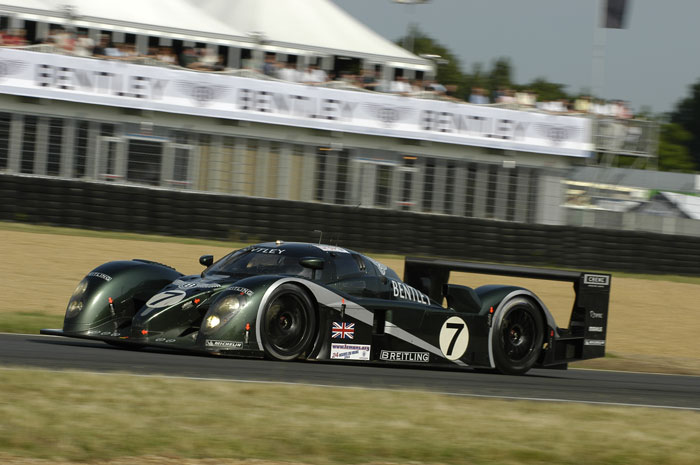 In 2003, Bentley returned to the top of the Le Mans podium after 73 years with this, the Speed 8.
In 2003, Bentley returned to the top of the Le Mans podium after 73 years with this, the Speed 8.
Sourcing some of its technology – including its modified 600bhp, 4-litre turbocharged V8 engine – from Audi, the Speed 8 had run for a couple of years before development reached the point where it was good enough to take top spot at the world’s most famous endurance race. The Speed 8 represented a return to the place where Bentley had made its name and established itself as a world-leading performance car brand. While the Speed 8 program ended within a few years, Bentley remains a force in motorsport with the GT3.
THE BENTLEY BOYS
When you think about the early days of motor racing, what springs to mind might be images of gallant young chaps – playboys, adventurers and mavericks – leaping into powerful cars for a quick dash around a circuit before retiring for champagne and cigars at the local pub. There was a sense of the nonconformist about those early racers – of wealthy young men with a taste for new experiences keen to test themselves in a new sport that was both dangerous and fast.
There may be no group more connected to this idea then the wonderfully named Bentley Boys, a group of young men who, along with company founder W.O. Bentley, achieved great fame for their racing exploits in the 1920s and 1930s.
They included diamond heir and future Bentley company boss Woolf Barnato, former fighter pilot Henry ‘Tim’ Birkin, medical doctor Joseph Dudley ‘Benjy’ Benjafield, aviator Glen Kidston, journalist Sydney ‘Sammy’ Davis, Frank Clement, John Duff, and the Australian racer and pilot Bernard Rubin, amongst a few others.
Bentley’s victories at Le Mans in in the 20s and 30s cemented the Bentley Boys legend. In 1924, John Duff and Frank Clement won in a Bentley 3 Litre; Dudley Benjafield and Sammy Davis took top spot in 1927, also in a Bentley 3 Litre; Woolf Barnato and Bernard Rubin stood atop the podium in 1928 after winning in the Bentley 4½ Litre; and Barnato would three-peat after winning in 1929 and 1930 in the Bentley Speed Six, the first time with Henry Birkin, and with Glen Kidston in 1930.
While racing circuits were where Bentley made its name, the Bentley Boys’ exploits off the racetrack helped to keep the company in the headlines.
One famous story concerned the 1930 race between a Bentley Speed Six driven by Barnato and the ‘Le Train Bleu’ express locomotive.
Back then, the express train ferried wealthy types from the port of Calais on the north coast of France to the Mediterranean resort towns in the south and back again. Barnato claimed he could beat the train from Cannes in the south back to Calais, and not only beat it but be at the bar of his London club (meaning a ferry trip across the Channel had to be navigated too) by the time the train reached the Calais station.
Incredibly, he did so with four minutes to spare.
Bentley paid a price for this feat (one that was worth paying one would think). Apparently, in response to his obvious speeding on public roads, the French authorities fined Barnato a pretty penny more than the £100 prize he won for the challenge victory, and Bentley itself was excluded from the 1930 Paris Auto Show.
Boys will be boys.
BENTLEY BENTAYGA
In recent years, or since the late ‘90s anyway, the SUV has become the most world’s most popular model family vehicle. Big and comfortable, the SUV is everywhere, replacing the big sedans and station wagons that used to fill the family car role.
This growth in popularity didn’t go unnoticed by the luxury car makers and now you can buy an SUV model from just about any brand you can think of – BMW has a whole series of X models to choose from, Porsche has the Cayenne, Lamborghini the Urus, Rolls-Royce the Cullinan and even Ferrari appears to have bowed to public demand and announced that it will deliver the Pruosangue Crossover sometime in 2022.
While it may have seemed inconceivable just a few years ago that Bentley would produce an SUV, it too joined the party in 2015 with the Bentayga. The company went all out on their version, with the all-wheel drive luxury vehicle being powered by VW’s six-litre, twin-turbo W12 engine delivering monster figures of 0-100km/h achieved in a touch over four seconds and a top speed over 300km/h.
While the Bentayga has been engineered to deliver off-road performance, it’s unlikely you’ll ever see it punching through outback undergrowth on a weekend bush-bashing trip and today you could, should you have a skip full of money, buy one of six Bentayga models – the V8, the V8 Design Series, the Hybrid, the Diesel and, at the top of the tree, the world’s fastest SUV, the 625bhp, 306km/h Bentayga Speed.
THE FUTURE
It’s highly likely that Bentley will continue to set incredibly high standards for automotive luxury and performance well into the future. In recent years, the company’s concept cars have shown that it is well prepared to embrace the technology advances that have been made and those that are predicted to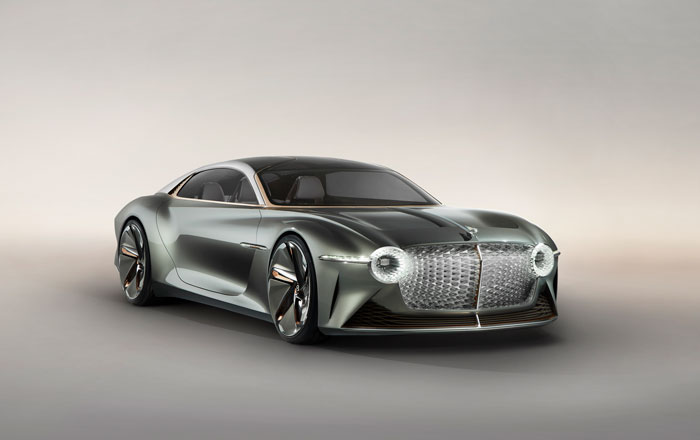 come down the pipeline. If its most recent concept – the EXP 100 GT – is anything to go by, then there are some exciting times ahead.
come down the pipeline. If its most recent concept – the EXP 100 GT – is anything to go by, then there are some exciting times ahead.
The all-electric piece concept offers an autonomous driving feature and is loaded up with high-tech wizardry and traditional craftsmen-style details. An AI system – the Bentley Personal Assistant – works to keep the driver and passengers comfortable by monitoring mood with biometrics and, the company says, it can even detect the driver’s blood pressure. It can alter the amount of light in the cabin, the temperature and other settings.
The car’s battery electric powertrain that will, Bentley says, offer a 0-100 km (0-60 mph) time of less than 2.5 seconds, a top speed of 300 kph (186 mph) and maximum torque of 1,500 Nm. That’s potent stuff.
MULLINER
For many of the early automotive manufacturers, building a car meant building what was known as a rolling chassis. This was the mechanics of the car – the engine, drivetrain, suspension, wheels and everything else required for it to move. The bodywork and the interior, on the other hand, were the domain of the coachbuilder, specialist firms of craftsmen who would design and build bodies to customer’s demands that would then grace the rolling chassis.
Plenty of well-known companies were originally established as coachbuilding businesses including Tickford, Pininfarina and, of course, Holden.
In Bentley’s case, the coachbuilder most associated with the company was Mulliner, which first built bodies for Bentley with a two-seater 3 Litre, exhibited at the Olympia Show in London in 1923. It would go on to be closely aligned with Bentley and its most famous and luxurious cars until 1959, when the age of the independent coachbuilder was coming to an end and the company officially became part of Bentley Motors.
The Mulliner name lives on in the Bentley brand, however, and it continues to be used to personalise and modify cars to the requests of customers and is the mark of the most luxurious Bentley models.
Original source: Motor Trader Magazine (September 2019)
10 Sept 2019




